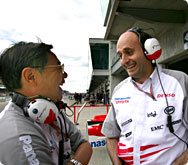| The V8 is an Extremely Stimulating Challenge
What processes are involved to ensure all the varying factors of engine design and build are fully incorporated into the final product?
Overall performance is a series of components and not just power-related. We have to consider the engine weight, the centre of gravity. Both of these are important parameters, but also the integration of the engine with the chassis. Having everything working under the same roof is therefore a big advantage that we enjoy at Toyota. For example, most activities on the exhaust are now more aero-driven than engine-related. Additionally, on engine design for 2005, one of the biggest changes actually came
from optimisation of fixation points, so working under one roof helps us massively in conquering these hurdles.
What do you foresee as the technical challenges with the 2.4l V8 engine in 2006?
We accepted this technical challenge in a very positive way. The V8 is a new engine and even if we use a lot of internal parts that are similar to its V10 brother, it is a completely new unit. The level of limitation that the FIA has given us is quite high, but the project still makes our job technically stimulating. We are now trying to have a V8 that revs at similar levels or even higher than the best V10. This poses a good challenge for all auxiliary parts related to the engine, given the much
higher level of vibration. We are quite ahead with our targets at the moment, even if we are struggling a bit with reliability, but we also did some valuable runs in Jerez in July and we are working to our plan well.
The Important Relationship between Engine and Driver
Can you explain the term “engine driveability” to us?
In F1, with traction control, the driver can theoretically run at full throttle into a corner and the rest is taken over by electronics. Honestly this is not the case because if the engine is difficult to drive – and by that I mean that the torque gradient is really rough -the work that must be done by the electronics is much higher and leads to greater oscillation of the drive train. This places a particular emphasis on engine driveability and is one of our prime targets for development. Olivier
Panis asked us from the beginning of his involvement with Toyota to have an engine that could be driven easily with no traction control and this means we develop the engine to be smooth enough for the driver to focus on performance rather than wasting concentration on controlling the engine. It can save a massive amount of time over one lap.
 |
 |
| |
Marmorini confessed that he was too nervous to watch the race in which Panasonic Toyota Racing won its first podium finish. To the left is Keizo Takahashi. |
What role does the driver play in engine development?
The feedback of the driver is very important. All four of our drivers – Jarno, Ralf, Olivier and Ricardo - are highly competent at developing the engine. I mentioned Olivier because we have been working with him for three years and we have recently given him the chance to take care of our new V8 baby and to head up development on that. For race preparation, the driver can already tell us before a race where the critical corners of the track will be for the engine, so we can start to do some
dyno activity well in advance to map the engine to support the driver during the weekend.
Every Day is Another Exhilarating Challenge
What would winning a race mean to you as leader of the entire F1 engine department?
Winning our first race will almost certainly be a huge celebratory day for me and my team. When we got our first podium in Malaysia this year, it was a fantastic day. People in the factory were visibly happy and the result removed a lot of collected bad moods. The team had an injection of motivation, so I can’t wait to see what effect the first win has. In Malaysia, the engine was running its second race and I was so nervous I barely watch the race at all. The resultant podium was amazing but
I only watched the final laps with one eye open!!
What advice do you have for aspiring young engineers?
The main message I would give is to say that if you love this kind of job in motorsport, it is not a closed environment. There is unfortunately nowhere for graduates to learn this trade, but with the right technical degree and through perseverance and gaining racing experience, it is possible. Even without my job, I would still be a fan of racing, so to work at Toyota is great – it is like a hobby. Everyday there are new things to do, new challenges to undertake and I relish this atmosphere.
As long as I can do this job, I will be happy.
|